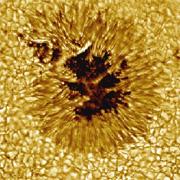 Sunspots eject plumes of gas hotter than a million degrees Celsius.© NASA
Sunspots eject plumes of gas hotter than a million degrees Celsius.© NASAThe past 70 years has seen the longest and most intense period of sunspot activity for 8,000 years, according to scientists who have reconstructed a record of the Sun's last 11,000 years.
Solar physicist Sami Solanki from the Max Planck Institute in Katlenburg-Lindau, Germany, and his colleagues found in November 2003 that the Sun is more active now than at any time in the past 1,000 years1. This, along with several record-breaking solar storms that occurred at around the same time, has triggered intense debate about why the Sun is now so active.
However, Solanki's latest data reveals that before 8,000 years ago, the Sun went through several short periods where it was just as active as it is today. This suggests that the current high is part of the Sun's normal activity and that it will probably calm down again, returning to normal levels within the next few decades, he says.
Sunspots are temporary dark patches on the Sun, caused when its magnetic field 'pinches' at the surface. The magnetic field is generated by hot, ionised gas that swirls around inside the star, acting like a dynamo.
"But we don't really know how the Sun's dynamo works," Solanki says. The new record will help solar physicists to model how that dynamo changes over thousands of years.
Scientists already have a good observational record of sunspots that dates back to the early seventeenth century. This shows that the Sun's activity varies on cycles that last roughly 11 and 88 years, although scientists are not yet sure why these cycles exist.
David Hathaway, a solar physicist from NASA's Marshall Space Flight Centre in Huntsville, Alabama, recently predicted that the Sun's current spotty outbreak was on the wane and should reach a minimum by 2006, although this will still be significantly more active that in previous centuries.
Ringing in the changes
 Sunspots are slightly cooler and less luminous than the rest of the Sun.© NASA
Sunspots are slightly cooler and less luminous than the rest of the Sun.© NASASolanki's team reconstructed their record by following an intricate scientific breadcrumb trail. Sunspots have extremely turbulent magnetic fields, which send extra bursts of charged particles hurtling towards Earth, and can potentially disrupt radio communications and damage satellites.
This boost to the solar wind also deflects more of the cosmic rays that normally bombard the Earth's atmosphere, so there are fewer cosmic rays to trigger nuclear reactions in the upper atmosphere that produce a heavy form of carbon called carbon-14.
When trees absorb this as carbon dioxide, they indirectly carry a historical record of the Sun's surface that can be dated by measuring the variation of carbon-14 in their rings. More sunspots means less carbon-14 in the tree's ring for that year.
"The models reproduce the observed record of sunspots extremely well, from almost no sunspots during the seventeenth century to the current high levels," comments Paula Reimer, a palaeoecologist from Queen's University Belfast in Northern Ireland.
Cold snap
The period between about 1650 and 1700, when astronomers saw virtually no sunspots, is known as the Maunder Minimum. It coincided with the coldest part of a chilly period on Earth called the Little Ice Age, and some scientists have speculated that this provides evidence that the Sun's activity significantly affects our climate.
"There's a really interesting debate about this at the moment," says Mike Hapgood, a space scientist from the Rutherford Appleton Laboratory, Didcot, UK. The sunspot record, published this week in Nature2, could help to settle the issue, he says.
Solanki stresses that without fully understanding the chain of cause and effect, we cannot be sure exactly how the changing Sun impacts on our climate. Greenhouse gases, generated by burning fossil fuels and volcanic eruptions, are probably far more important in controlling the Earth's temperature, he says.
